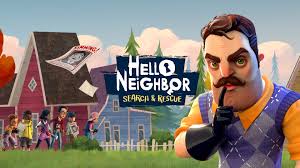Hello Neighbor
The Hello Neighbor franchise, developed by Dynamic Pixels and published by tinyBuild, has carved a unique niche in the stealth horror gaming world. Since its debut in 2017, this series has captivated players with its eerie premise, innovative artificial intelligence (AI), and a blend of puzzle-solving and sneaking mechanics. Spanning multiple games, spin-offs, and upcoming releases, the Hello Neighbor universe offers a thrilling experience set in the mysterious town of Raven Brooks. This article delves into the franchise’s evolution, gameplay, and cultural impact, highlighting why it remains a standout in indie gaming.

Origins and Core Concept of Hello Neighbor
Hello Neighbor, released on December 8, 2017, for Windows and Xbox One, introduced players to Nicky Roth, a young boy driven by curiosity to uncover the dark secrets hidden in his neighbor’s basement. The game’s premise is simple yet chilling: sneak into the neighbor’s house, avoid detection, and solve puzzles to unlock the basement’s mysteries. What sets it apart is the advanced AI that governs the neighbor, Theodore Peterson, who adapts to player actions by setting traps and altering his patrol routes based on past attempts. If you frequently climb through a window, expect a bear trap there next time. This dynamic AI system creates a tense, unpredictable cat-and-mouse experience.
The game’s cartoony art style belies its unsettling atmosphere, blending family-friendly visuals with psychological horror. The narrative unfolds through subtle environmental storytelling, revealing a tragic backstory involving Theodore’s family. Despite mixed reviews criticizing its clunky controls and illogical puzzles, the game’s novel concept and creepy vibe earned it a dedicated fanbase.
Expanding the Franchise: Prequels and Spin-Offs
The success of the original spawned a robust franchise. Hello Neighbor: Hide and Seek (December 2018) serves as a prequel, letting players control Mya Peterson, Theodore’s daughter, to explore the family’s tragic past. This narrative-driven game focuses on emotional storytelling, offering context for Theodore’s behavior in the original. Secret Neighbor (October 2019), a multiplayer social horror spin-off, pits a group of kids against a disguised neighbor in a cooperative yet deceptive mission to rescue a friend from the basement. Its social deduction mechanics, where one player is secretly the neighbor, add a layer of intrigue.
Hello Engineer (October 2021) shifts gears to a construction-based spin-off, where players build contraptions in a quirky, physics-driven environment. Meanwhile, Hello Neighbor 2 (December 2022) expands the setting to an open-world Raven Brooks, with players as Quentin, a journalist investigating the town’s mysteries. This sequel introduces multiple AI-driven neighbors, enhancing the sandbox gameplay and exploration. The upcoming Hello Neighbor 3, slated for 2025, promises a cozy yet eerie adventure in a half-abandoned Raven Brooks, emphasizing player choice and real-time simulation.
Gameplay Mechanics and Challenges
At its core, Hello Neighbor combines stealth, puzzle-solving, and exploration. Players must navigate increasingly complex environments, from Theodore’s sprawling house to entire neighborhoods. The AI’s adaptability is a double-edged sword: it creates immersive tension but can frustrate with inconsistent behavior, like detecting players through walls or ignoring obvious clues. Puzzles, often criticized for their lack of clear guidance, require trial and error, such as freezing a pool with a globe or finding hidden keys.
The franchise’s stealth mechanics encourage creativity—hiding in cabinets, throwing objects to distract the neighbor, or exploiting glitches like the “trash can glitch” for unintended advantages. While the forgiving save system ensures minimal progress loss, the lack of tutorials and vague objectives can alienate new players. Still, the series rewards persistence, with basement segments delivering creepy payoffs and surreal visuals, like rollercoasters or water-filled rooms.
Cultural Impact and Community Engagement
Hello Neighbor gained traction through YouTube streamers, whose exaggerated reactions to the neighbor’s traps fueled its popularity. Its enigmatic design—akin to a puzzle box—encouraged community collaboration on forums and Discord to decipher its secrets, much like Grand Theft Auto V’s Mount Chiliad mystery. The franchise’s cross-platform availability, including PlayStation 4, Nintendo Switch, iOS, Android, and Google Stadia, broadened its reach.
The series also inspired a film adaptation in development by Boulderlight Pictures, signaling its cultural footprint. Fan creations, like the proposed “Uh…Hello, Neighbor?” hand-drawn game, showcase the community’s passion. However, some fans lament the franchise’s shift from thriller mystery to less scary, more surreal narratives, with glitches and unpolished mechanics drawing criticism.
Looking Ahead: The Future of Hello Neighbor
With Hello Neighbor 3 on the horizon, the franchise continues to evolve, promising deeper immersion and player-driven storytelling. Its blend of stealth horror, AI innovation, and sandbox exploration keeps it relevant in the indie gaming scene. Despite flaws, the series’ ability to evoke curiosity and unease ensures its lasting appeal. For fans of mystery, horror, and creative problem-solving, Hello Neighbor remains a bold, if imperfect, adventure worth exploring.

